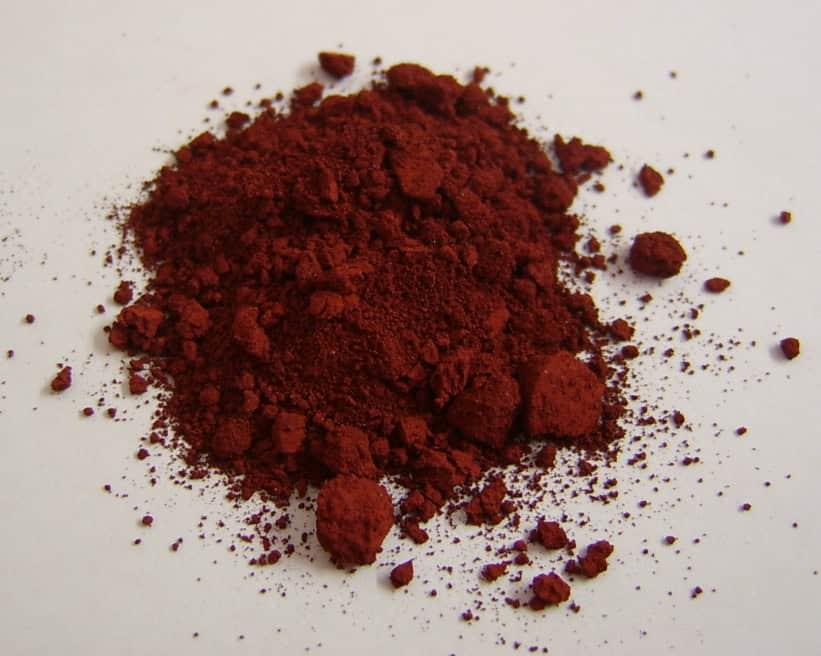
Difference between Iron Oxide and Iron Hydroxide
At first glance they may seem similar, but their differences in composition, properties and uses are essential for numerous applications.
In this article we will try to explain the difference between these two compounds.
Chemical composition of Iron oxide
The composition of iron oxide, also called ferric oxide or Fe2O3, is a chemical compound formed by iron and oxygen. Its crystalline structure gives it stability and resistance to corrosion. This compound, red, can have yellowish or bluish undertones depending on its purity as well as its particle size and shape. It can be of various colors, from red to yellow, depending on the impurities it presents.
This is the form of oxide commonly seen in iron and steel structures that are oxidized. This oxide damages and alters structures from bridges to car bodies, so it is considered highly destructive in certain circumstances, as for other utilities it is an essential compound.
A peculiarity is that due to its electronic configuration, iron oxide is a chemical compound that does not conduct electricity.

Chemical composition of Iron hydroxide
Iron hydroxide is formed by oxygen, iron and hydrogen. It can be found in anhydrous form, expressed its formula in this way FeO(OH) or hydrated of which formula is FeO(OH)·nH2O, commonly Fe(OH)3.
This compound is formed when iron is exposed to oxygen and water. It is popular for its ability to absorb contaminants from water, such as heavy metals.
Extraction of Iron oxide (Fe2O3)
Natural iron oxide is extracted from mines, once extracted, this material goes through a selection process where it is classified by its iron oxide content, then it goes to the grinding and classification phase and finally to the packaging phase, which then goes to be marketed in the different industrial markets.
As for synthetic iron oxide, it is produced by various reaction routes. The oldest known is the Laux route, in which the pigment is a by-product of the aniline production reaction. The Laux process offers a wide range of colors, with special strength in the medium and bluish red tones, as well as a relatively hard consistency of the primary particles.
The strong point of the Copperas and Penniman routes lies in their bright and yellowish color space, which can only be achieved to a limited extent by the Laux process.
Extraction of Iron hydroxide
Natural iron hydroxide, commonly known as goethite (FeOOH), can be extracted in various ways, depending on its form and the source from which it is obtained.
This substance is commonly found in nature in the form of minerals such as goethite or lepidocrocite.
Goethite can also be synthesized, like iron oxide, by various crystallization routes. The materials thus obtained are usually used as pigments for their high purity and homogeneity in particle size and shape.
Among the processes of synthesis of iron hydroxide or Fe(OH)3 we can find the leaching process or the electrolysis.
Leaching process:
Once we have the mineral, it is ground to increase the contact surface. Once ground, it is treated with chemicals (such as hydrochloric acid) to dissolve the iron hydroxide in a solution.
By a precipitation process, the solution is neutralized causing the precipitation of the iron hydroxide, once the solution is precipitated, it is filtered and dried to obtain the final product.
Electrolysis:
Electrolysis consists of preparing a salt solution that contains iron ions. By applying electricity through the solution, the iron ions are reduced and form solid iron hydroxide at the cathode, which is then collected and prepared for marketing.
All these methods can vary depending on the specific type of iron hydroxide and the source of the mineral.
Utilities of Iron oxide
Iron oxide is a very useful and special material that is used in a wide variety of industries. It has many ways of being used that are of great help both in the industry and in the protection of the environment. Some of the industries that it favors are the following:
Cement Industry:
Iron oxide plays a stellar role in the cement industry, providing color and character to a variety of constructions, from walls and pavements to terraces and tiles. Its use in mortars, grouts and stuccos enhances the aesthetics and durability of these materials.
Paint Industry:
Its high tinting power and stability make it an exceptional pigment for the paint industry, offering a range of shades and guaranteeing color retention over time. Whether in decorative paints, enamels or priming processes, iron oxide stands out for its reliability and superior performance.
Ceramic and Glass Industry:
In the field of ceramics and glass, this compound confers color and resistance, allowing the creation of unique and durable pieces.
Steel Industry:
Iron oxide is, on the one hand, raw material for the steel industry, and on the other a key participant in the protection and treatment of steel structures in the form of protective paints, helping to combat corrosion and prolong the useful life of these materials.
Animal Feed:
In animal nutrition, it serves as a mineral supplement, contributing to the well-being and optimal development of livestock.
Water Treatment:
Iron oxide is effective in removing impurities and water treatment, ensuring a safe and sustainable water quality.
Pharmaceutical Industry:
In the pharmaceutical sector, it is used in various formulations, supporting the creation of safe and effective drugs.
Colorant in Cosmetics:
Its ability to provide color, along with its safety profile, makes it a valuable resource in the cosmetic industry, providing color in a variety of products from makeup to tattoo inks.
These applications highlight the relevance and versatility of iron oxide, a compound that continues to play a central role in technological advances and industrial solutions.
Utilities of Iron hydroxide
We find that compounds such as iron hydroxide, are very useful in different industrial and environmental sectors. Iron hydroxide, by its shape and special characteristics, plays an important role in helping in many necessary processes in different industries. Below, some of the main ways in which this compound helps are explained, showing how valuable and versatile it is both in our day to day and in the industry.
Treatment of Wastewater and Drinking Water:
Iron hydroxide not only plays a crucial role in water purification, but also facilitates the effective removal of contaminants such as phosphates and arsenic. Its ability to absorb impurities makes it an invaluable resource in water treatment.
Pigments in Paints and Inks:
The paint and ink industry benefits greatly from the range of colors that goethite can offer. Its stability and resistance to fading make it a preferred choice for pigments.
Cosmetic Industry:
The safety and variety of shades that iron hydroxide provides make it essential in the formulation of cosmetic products and tattoo inks.
Pharmaceutical Industry:
In the pharmaceutical industry, iron hydroxide is used in certain formulations due to its proven safety and efficacy profile.
Paper and Textile Production:
In paper and textile production, this compound contributes to the quality of the product, and in some cases, to its aesthetics.
Treatment of Industrial Effluents:
Its ability to neutralize and eliminate harmful substances makes it an ally in the treatment of industrial effluents.
These applications highlight the versatility and importance of iron hydroxide in our daily life and in the industry. Iron hydroxide will continue to be an essential resource to face many industrial and environmental challenges in the coming years.
Conclusions
Iron Oxide (Fe2O3) and Iron Hydroxide (Fe(OH)3 / FeO(OH)) are iron compounds with significant differences in their structure and properties, which give them different utilities in various industrial and environmental sectors. Iron Oxide is characterized by its stability, resistance to corrosion and its versatility in various industries such as cement, paints, ceramics, steel, and cosmetics, among others.
On the other hand, Iron Hydroxide, is a molecular compound, is recognized for its ability to absorb contaminants from water, which makes it invaluable in the treatment of wastewater and drinking water. It also has applications in the paint, cosmetic, pharmaceutical, and paper and textile industries, thanks to its safety profile and variety of shades that it can offer.
The extraction of both compounds can be done in different ways, including the extraction of minerals, crystallization, leaching and precipitation or electrolysis, each with its particularities depending on the specific type of compound and the source of the mineral.
Both compounds show a remarkable versatility and relevance in multiple industrial and environmental sectors, underlining their importance in daily life and in technological advancement and industrial solutions. The continuous exploration and discovery of new applications of these iron compounds will open doors to new solutions and discoveries that will benefit society and industry in the future.
Link nội dung: https://career.edu.vn/feoh2-fe2o3-a57815.html